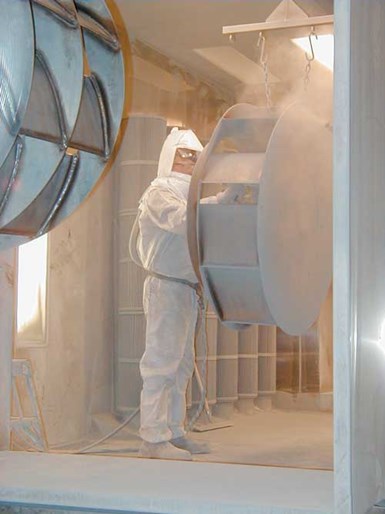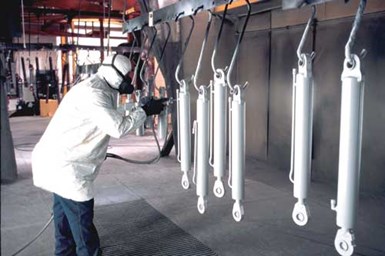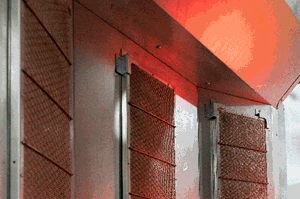Fundamentals of Liquid Coatings for Finishing Operations
Before liquid coatings are selected for the industrial finishing line, it is important to have a solid understanding of how a coating works.

Liquid coatings are the highest-volume finish type for OEMs and product finishers.
Increasing concern about the environment and the resultant consumer demand for environmentally preferable products has influenced the products finishing industry across all markets and end-uses. While manufacturers look to meet these demands without significant changes to productivity or cost, advances in raw materials and technologies have made it easier to produce more ecologically friendly products in a more sustainable manner. As governmental regulations and the influence of specification programs that regulate air quality and other environmental attributes grow, the wider range of technology and processing options available today provide finishers and manufacturers with greater flexibility to stay competitive in the evolving production landscape.
The technology used in creating coatings has never been better than it is today. Whether it be the types of raw materials available, new methods of combining materials or the evolution of traditional technologies, coatings provide a range of options for finishers to meet the range of environmental, performance and appearance requirements. This is especially true of liquid coatings, the highest-volume finish type for OEMs and product finishers. Before any coatings are selected for the finishing line, it is important to have a solid understanding of how a coating “works.” An appreciation of the components of a coating and how these raw materials come together to achieve performance, adhesion and application properties provides a knowledge base for a value-added coating selection.
Coating Composition

Titanium dioxide and other colored pigments are used to provide hiding and color, while other types of pigments influence resistance to corrosion and weathering, as well as overall durability.
There are four basic ingredient classes found in all liquid coatings: binders, pigments, carriers and additives. In combination, these components create a liquid technology that dries to a film, providing protection and aesthetics. Each of these four components is integral to the coating composition.
Binders are the non-volatile resins that provide the foundation for any coating. The choice of binder directly influences the performance and choice of appropriate end-use applications for any coating, as well as much about the final appearance. Classifications of binders for coatings include emulsions (acrylic or vinyl), dispersions (acrylic, alkyd or polyurethane) and solutions (alkyds, polyesters, epoxies, acrylics and urethanes). There are also hybrids of these technologies, such as acrylic urethanes and polyester urethanes. Many of these, like alkyd resins, have been formulated so that versions of the binder are available for use in both solvent-borne and waterborne formulations, increasing the range of appropriate end-users for water-based technologies.
The binder selection in coating development often involves a trade-off between performance and cost, and is dictated by the intended end-use of the finish. For example, applications that require significant resistance to corrosive environments require the use of more technologically advanced resins, such as epoxies and urethanes, adding cost to these finishes. Since using a product developed for such extreme conditions in an interior residential application would be overkill, products developed for decorative use instead include vinyl acrylic resins that provide an appropriate level of protection at an appropriate cost. Depending on the end-use requirements, multiple resins can be combined into a hybrid mixture designed to deliver performance capabilities tailored around the application. Regardless of technology used, binder choice dictates the degree of adhesion, the dry time characteristics, and much about the final appearance and performance of any coating. Researching coating properties and working with your coatings supplier can help you best understand the difference between the types of coating technologies available to quickly narrow down technology options.
Pigments also provide strong influence into the appearance and performance of a coating. Finely ground, solid particles, pigments can be both mineral and polymeric in nature. The volume of pigments in a coating correlates with the gloss of the film, with greater pigment loading resulting in lower gloss coatings. Flat paints have such a high pigment loading that some pigment actually sticks out from the dried paint film, dropping the gloss but decreasing the overall durability. Product manufacturers generally choose gloss coatings—in part because of the performance needed is better achieved with higher gloss products, and in part because of the quality final appearance provided.
Carriers are an important component of any paint formulation. The carrier is the main liquid in a coating formulation, and can be water, a solvent or any blend of the above.
Thus, the role of the pigment in factory-applied coatings is generally to provide color and performance. Titanium dioxide and other colored pigments are used to provide hiding and color, while other types of pigments influence resistance to corrosion and weathering, as well as overall durability. An example of this would be zinc-based pigments providing corrosion protection in primers.
Carriers are an important component of any paint formulation. The carrier is the main liquid in a coating formulation, and can be water, a solvent or any blend of the above. The pigments are dispersed into the binder with the aid of the carrier, which also helps reduce the viscosity of the coating so that it can easily be applied. There needs to be a synergy between the carrier and binder, as the binder needs to remain stable and able to form a film despite the drop in viscosity and addition of other raw materials. The choice of carrier also influences application, as different types of carriers have different evaporation and dry time rates. Especially with solvents, carrier choice requires deciding between dry time, environmental restrictions and process needs. For example, using only fast-dry solvents may be optimal for processing, but may not meet regulatory needs and can even result in film deformities from speeding the dry time too much. Combinations of carriers allow for meeting the most complete needs of the formulation and application process.
Additives are the final component of paint. A far-ranging classification, these raw materials offer special performance qualities, such as rust inhibition or UV protection. Generally, additives make up a small percentage of the overall paint composition but can be integral in meeting the performance needs of finishers.
Environmentally preferable finishing options take advantage of advances across the classifications of raw materials. From water-reducible binders that allow the use of water as a solvent to high solids technologies that lower VOC by reducing solvent requirements to the use of exempt and lower
VOC solvents, finishers have a wider range of technology options that can help their products and process be more ecologically friendly.
Paint Film Formation
Regardless of application method, once a coating is applied, there are four basic mechanisms that allow the paint film to form: evaporation, coalescence, oxidation and chemical curing.
Evaporation is the simplest form of film formation and involves the release of the carrier after application. Lacquers dry by this mechanism. As the carrier evaporates, it leaves behind a solid coating without any chemical or structural change to the rest of the raw materials. Coatings that dry through evaporation usually take 10-30 minutes to fully cure.
Coalescence is the film formation process for latex emulsion coatings. In a latex paint, the long strands of latex polymers are dispersed throughout the liquid mixture. Once applied, the water begins to evaporate and leave the paint film. As the percentage of water drops, the polymers start to become more closely packed together. After enough water evaporates, the long chains become so tightly packed that they begin to fuse together, or coalesce, to form a film. This film can form in as little as 30 minutes, but it can take up to a month for the film to fully cure.
Oxidation is a two-step process for film formation. First the coatings dry by solvent evaporation. Then the binder mixture reacts with oxygen from the air to cure and harden further. Coatings that dry via oxidation first go through a 10-minute evaporation stage to lower the percentage of carrier in the film and expose more of the binder to the air. Then oxidation begins as the remaining ingredients begin to react with oxygen in the atmosphere. Alkyd coatings are a great example of oxidation in that the alkyd resin and drier additives in the formulation begin to chemically crosslink with each other once exposed to oxygen, creating a film. The film formation and curing process generally takes between four and six hours. However, the paint film will continue to oxidize for the life of the coating, with this continuous crosslinking providing an understanding why old alkyd paint becomes brittle. The simultaneous requirements for solvent evaporation and a constant oxygen supply also explains why good air movement directly impacts the cure time of many conventional coatings.
Emissions are a key regulation that finishers face, and the type of cure doesn’t necessarily reduce or increase the VOC, although the selection may result in emissions of other chemicals that may be regulated, such as formaldehyde.
Finally, chemical curing occurs when small molecules react to form larger and larger molecules, resulting in a cured film. Epoxies and two-part urethanes are examples of this type of curing mechanism. As with the other means of forming a film, the first part of chemical curing is a 10-minute evaporation of the carrier, followed by a chemical reaction that can take anywhere from 30 minutes to several hours, depending on the formulation. Chemical curing can provide more durable and forgiving film, and is often used for higher-performance end-uses.
The type of curing process has less of an impact on regulations and VOC than the type of technology used. Emissions are a key regulation that finishers face, and the type of cure doesn’t necessarily reduce or increase the VOC, although the selection may result in emissions of other chemicals that may be regulated, such as formaldehyde. However, more intense curing mechanisms like chemical curing result in a more durable finish and may help finishers make lasting products that are ultimately more sustainable.
Matching Needs to Performance
An understanding of the composition and curing process of coatings provides insight when making a coating selection, helping finishers match their product choice to their performance, regulation and application requirements. Understanding the basics about technology also makes it easier to understand when environmentally preferable technologies may be a viable finishing choice. The first decision in coating selection is often to consider the general type of technology preferred—solvent-borne, high-solids and waterborne. Choosing a specific technology type for finishing requires matching up the application and performance attributes with end-use requirements, customer specifications and regulatory guidance.
Solvent-borne coatings are often referred to as the workhorses of the industry because of their reputation for providing long-lasting finishes that dry quickly and meet high-production schedules. Available as total-coating systems, solvent-borne products are available for a wide range of coating needs with product types that include fillers, primers, sealers and topcoats. The breadth of solvent-borne formulations have been formulated to meet the specific but varying demands for gloss, color retention and chemical resistance across industries and end-uses.
The durability and long-lasting appearance characteristics historically provided by solvent-borne products has made them a popular choice for metal finishing applications as diverse as military, industrial, agricultural, construction equipment, office furnishings and consumer electronics. In fact, solvent-borne dominates the listing of federal standards because of their long history and the general comfort with the technology and the performance it provides.
Finishers who want very durable coatings for plastic substrates have also turned to solvent-borne coatings, since they offer exceptional film durability, long-term performance and superior texturability over this substrate. The plastics industry also values solvent-borne finishing materials for their ability to cure below 300°F, the deformation temperature for many plastics.
While past solvent-borne formulations were developed with performance and application needs in mind, advantages in solvent-borne technologies and raw materials have helped make finishes more environmentally friendly. There are many coatings options that meet government regulations and the various specifications related to HAPs and VOCs. For example, ultra-low-VOC polyester baking enamels that emit less than one lb/gal of VOCs are available that offer finishers excellent application and performance characteristics. Even traditional solvent metal enamels are now available in lower-VOC and HAPs-free formulations.
The challenge for manufacturers in the development of these coatings has been to deliver a product that can be applied easily with conventional equipment.
Coatings suppliers are also adopting more eco-friendly manufacturing processes for solvent-borne coatings, improvements that have been leveraged across technologies. Practices such as solvent recovery, waste-product reuse and better containment to reduce solvent emissions are proactive sustainability gains that minimize the overall impact of the producing solvent-borne finishes. Such practices are becoming more customary within the coatings industry, as are other environmentally focused manufacturing improvements such as higher-efficiency lighting and more streamlined processing practices.
High-solids coatings have their own advantages as a technology choice. Containing less solvent than conventional materials, there are fewer emissions and greater transfer efficiency of the coating. Available in single- or two-component systems, high-solids coatings technologies include polyesters, alkyds, epoxies, urethanes and acrylics.
High-solids coatings are generally defined as those that have at least 60 percent solids content by volume, with some products even exceeding solids content of 90 percent. The challenge for manufacturers in the development of these coatings has been to deliver a product that can be applied easily with conventional equipment. Since solvents lower the viscosity of the coating in the container and provide the optimal application characteristics, finding a way to maintain conventional application while minimizing solvent use provides an additional challenge during the development of these products. Using unique raw materials, including polymers with lower molecular weight and more efficient solvents, formulations with standard viscosities and properties similar to conventional technologies are easily achieved.
Advances in polymer technology have driven the development of high-solids coatings. Ongoing research and development has led to new polymers that act as both solvent and binder. Using these polymers in high-solids formulations lowers the molecular weight and/or viscosity of the coating, resulting in better gloss retention, flow and leveling, and adhesion. In fact, current high-solids coatings can offer the same or improved performance characteristics as their high-quality, conventional low-solids counterparts.
The development of new cross-linking technologies has also led to gains with high-solids coatings. Often used in conditions where they are expected to cure despite a challenging environment, high-solids coatings are also required to provide top performance characteristics. Crosslinking technologies have been developed that maximize the performance of polymers while reducing initial viscosity, making application easier. The combination of high-solids melamine crosslinkers with high-solids polyesters to create attractive coatings for appliances, office furnishings and recreational equipment is a great example of crosslinking technology at work. In addition to creating a wide range of highly durable, attractive finishes, manufacturers have used crosslinker/polymer combinations for more specialized applications, like coatings that cure at room temperature or with UV/EB energy systems that are ideal for substrates such as wood and plastics. The industry is getting closer to its goal of creating 100-percent solids formulations that can be cured by conventional baking systems.
For many years, waterborne coatings were considered an inferior coating choice compared to solvent-borne options because they did not provide the same tough and long-lasting performance characteristics and had different dry time needs. But increased consumer interest and the growth of governmental regulations has driven technological improvements in waterborne finishes, creating product options that are in many ways equal, or in some cases better than, solvent-borne finishes.
Waterborne coatings get their performance characteristics in part from more highly engineered raw materials, like synthetic polymers that are used in combination with additives that give the coating a faster dry time and excellent adhesion to substrates. From resins to raw material combinations, the technology for waterborne finishing has improved, and manufacturers have put more resources into creating these types of coatings options for finishers. Waterborne coatings can be applied to the full range of substrates—wood, metal, glass, masonry and plastic—using most types of application equipment, including spray, dip or flow coating. Some waterborne coatings will air-dry, while others require baking to cure.
Waterborne finishing options provide the significant advantage of lower VOC. With most waterborne coatings offering VOC levels well below the 2.0 lb/gal levels and zero HAPs, these formulations provide the flexibility that finishers need to meet the evolving regulatory and consumer needs. Additional advantages of waterborne finishes include lower costs related to reduction and cleanup, an improved work environment with lower odor and the potential reduction in insurance costs.
Waterborne coatings come in different types of formulations that contain one of three types of polymer resin technologies—water-reducible, water-solubilized and water-emulsion. Since these polymers have significant differences, each provides its own specific set of characteristics to the finished product.
Related Content
Oven Door Technology Improves Energy Efficiency
The RollSeal Door brings a compact, energy efficient and safe design to batch and conveyor style thermal processing units.
Read MoreSpecialty Oven’s Hot Benefits and Other Questions Answered
Learn about the advantages of gas catalytic infrared pre-gel ovens in this article, including how they are energy efficient and can save users time and money when integrated into their existing systems.
Read MoreCatalytic Gel Ovens Offer Small Operational Footprint
WolfRayet catalytic gel ovens offer small operational footprints while also providing a way to improve on existing convection curing.
Read More5 Maintenance Tips for Gas Catalytic IR Ovens
Basic and periodic preventive maintenance is essential for avoiding oven downtime.
Read MoreRead Next
Education Bringing Cleaning to Machining
Debuting new speakers and cleaning technology content during this half-day workshop co-located with IMTS 2024.
Read MoreA ‘Clean’ Agenda Offers Unique Presentations in Chicago
The 2024 Parts Cleaning Conference, co-located with the International Manufacturing Technology Show, includes presentations by several speakers who are new to the conference and topics that have not been covered in past editions of this event.
Read MoreDelivering Increased Benefits to Greenhouse Films
Baystar's Borstar technology is helping customers deliver better, more reliable production methods to greenhouse agriculture.
Read More











.jpg;maxWidth=300;quality=90)









